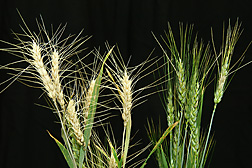Diverse Wheat Tapped for Antifungal Genes
Asian wheat may offer novel genes for shoring up the defenses of U.S. varieties against Fusarium graminearum, the fungus that causes Fusarium head blight (FHB), ARS studies suggest.
Several Fusarium species cause FHB worldwide, but in the United States the most problematic to wheat (and barley) is F. graminearum. For example, an epidemic that swept through the Great Plains from 1998 to 2000 cost America’s wheat industry $2.7 billion in losses.
Guihua Bai, a plant molecular geneticist in ARS’s Hard Winter Wheat Genetics Research Unit, Manhattan, Kansas, is working to prevent a repeat disaster by broadening the suite of FHB-resistance genes now available to U.S. wheat.
According to Bai, only a few resistant sources are used in wheat breeding programs—the Chinese wheat variety Sumai 3 among them. But the fungus is an adaptable foe, and there’s concern that FHB-causing species will overcome resistant sources like Sumai 3. Bai and colleagues at Kansas State University-Manhattan have sought new sources of resistance from exotic wheat lines collected from China, Korea, and Japan. These lines include old “landrace” populations—domesticated plants that have changed little since the advent of modern plant breeding.
In greenhouse trials, the researchers inoculated the Asian wheats with F. graminearum spores and compared their responses to seven commercial varieties, including the resistant Sumai 3 and the susceptible Wheaton.
Of 87 total Asian accessions tested, 26 showed high levels of FHB resistance. Grain evaluations revealed that 15 accessions had exceptionally low levels of the fungal toxin deoxynivalenol, which is produced during disease development and can reduce the value of affected kernels as food or feed.
Six of the resistant accessions possessed genes for three different forms of FHB-resistance, known as types I, II, and III. “Some of these genes appear unrelated to those in Sumai 3,” says Bai. This work suggests that the Asian lines could indeed add depth to the genetic pool of resistance now available for breeding U.S. wheat varieties.
Using genomic tools, Bai’s team has begun hunting for molecular markers (small pieces of DNA used in diagnostic tests) to speed identification of other novel resistance sources and top-performing offspring of crosses made between resistant germplasm and elite commercial varieties.
On a related front, the team also worked to better characterize the three types of FHB resistance. Type I, which manifests as barriers to initial infection, may be least accessible to wheat breeders. “Type II is resistance to the spread of FHB symptoms in a wheat spike, and it appears to highly correlate with type III—low levels of the toxin,” Bai says. Thus, he adds, selecting for type II resistance should be a top priority when breeding for overall resistance to FHB.—By Jan Suszkiw, Agricultural Research Service Information Staff.
This research is part of Plant Genetic Resources, Genomics, and Genetic Improvement (#301) and Plant Diseases (#303), two ARS national programs described at www.nps.ars.usda.gov.
Guihua Bai is in the USDA-ARS Hard Winter Wheat Genetics Research Unit, Grain Marketing and Production Research Center, 4008 Throckmorton Hall, Kansas State University, Manhattan, KS 66506; (785) 532-1124.
"Diverse Wheat Tapped for Antifungal Genes" was published in the April 2010 issue of Agricultural Research magazine.







